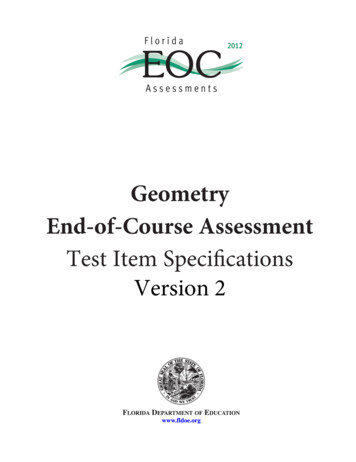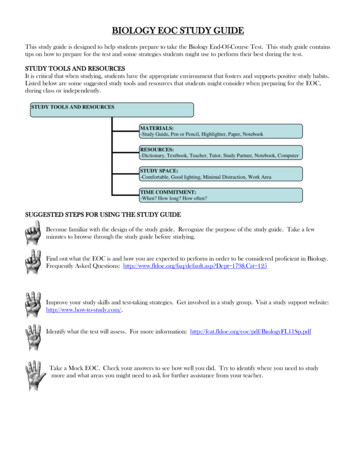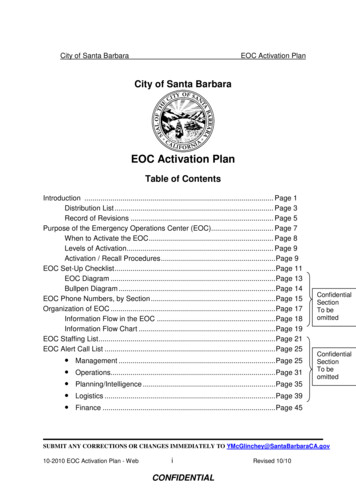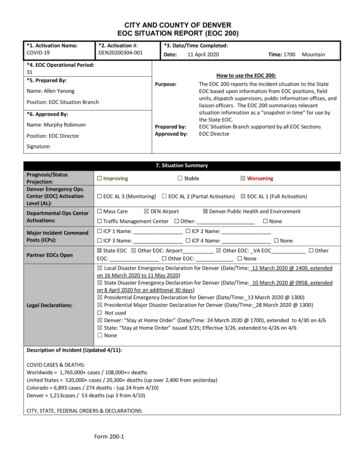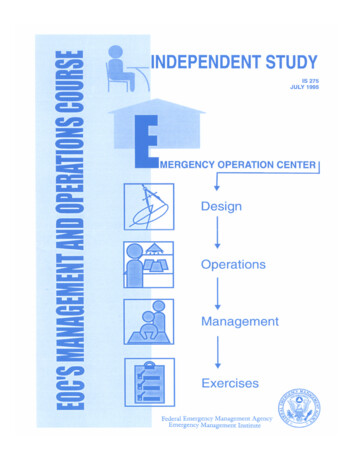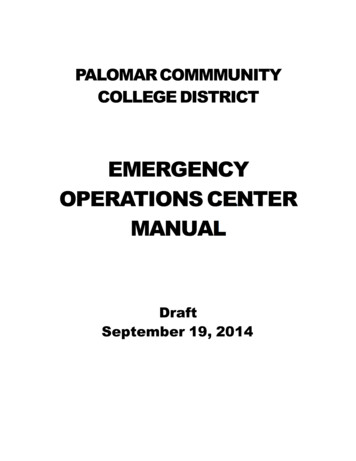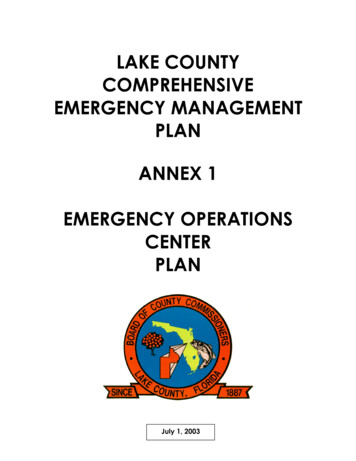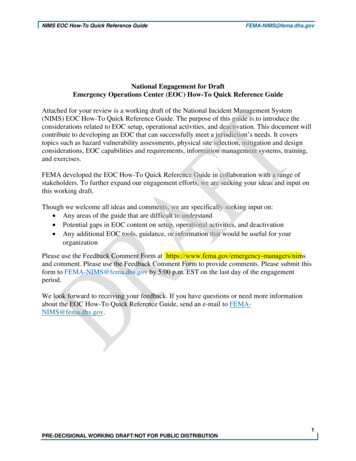
Transcription
NIMS EOC How-To Quick Reference GuideFEMA-NIMS@fema.dhs.govNational Engagement for DraftEmergency Operations Center (EOC) How-To Quick Reference GuideAttached for your review is a working draft of the National Incident Management System(NIMS) EOC How-To Quick Reference Guide. The purpose of this guide is to introduce theconsiderations related to EOC setup, operational activities, and deactivation. This document willcontribute to developing an EOC that can successfully meet a jurisdiction’s needs. It coverstopics such as hazard vulnerability assessments, physical site selection, mitigation and designconsiderations, EOC capabilities and requirements, information management systems, training,and exercises.FEMA developed the EOC How-To Quick Reference Guide in collaboration with a range ofstakeholders. To further expand our engagement efforts, we are seeking your ideas and input onthis working draft.Though we welcome all ideas and comments, we are specifically seeking input on: Any areas of the guide that are difficult to understand Potential gaps in EOC content on setup, operational activities, and deactivation Any additional EOC tools, guidance, or information that would be useful for yourorganizationPlease use the Feedback Comment Form at https://www.fema.gov/emergency-managers/nimsand comment. Please use the Feedback Comment Form to provide comments. Please submit thisform to FEMA-NIMS@fema.dhs.gov by 5:00 p.m. EST on the last day of the engagementperiod.We look forward to receiving your feedback. If you have questions or need more informationabout the EOC How-To Quick Reference Guide, send an e-mail to FEMANIMS@fema.dhs.gov.1PRE-DECISIONAL WORKING DRAFT/NOT FOR PUBLIC DISTRIBUTION
NIMS EOC How-To Quick Reference GuideFEMA-NIMS@fema.dhs.govThis page intentionally left blank2PRE-DECISIONAL WORKING DRAFT/NOT FOR PUBLIC DISTRIBUTION
NIMS EOC How-To Quick Reference GuideFEMA-NIMS@fema.dhs.govContentsI.Introduction . 7Purpose . 7NIMS Compliance and Integration . 7II.What Is an EOC? . 8Hallmarks of an EOC . 8III. Preliminary Assessments . 10Hazard and Vulnerability Assessment . 10Resilience Analysis and Planning Tool . 10Capability Assessment . 10Interagency Coordination . 11Private Sector . 11EOC Staffing Requirements and Structure Type . 12EOC Facility Support . 16Plans and Procedures . 16Lifelines . 17IV.Site Selection . 18General Considerations . 18Vulnerability . 18Central Location and Proximity to Key Personnel . 18Traffic Flow and Congestion . 19Accessibility . 19Parking . 19Communications . 19Security . 20Expandability . 20Community-Based Design . 20Alternate Sites. 20Existing EOC Sites . 21Mitigation Considerations. 21Natural Hazards . 21Technological and Human-Caused Hazards . 21V.EOC Capabilities and Requirements . 22Determining Personnel Space Requirements . 22EOC Functions . 22Space Requirements. 22Additional Personnel Space Requirements . 23Sustained Operations . 23Communications Requirements . 23Interoperability . 23PRE-DECISIONAL WORKING DRAFT/NOT FOR PUBLIC DISTRIBUTION3
NIMS EOC How-To Quick Reference GuideFEMA-NIMS@fema.dhs.govTelecommunications (Including Teleconferencing, Videoconferencing, Text Messaging andFax) . 23Public Safety Radio . 24Information Technology (IT) Requirements . 24Internet Connectivity . 24Computer Systems . 25Audiovisual Support . 25Supplies and Equipment Requirements . 25Furniture and Office Equipment . 25Food Supply . 25Medical and Sanitary Supplies . 26Status and Situation Boards . 26Administrative Supplies. 26Support Services . 26VI.Room Design Features . 27Design Considerations . 27Basic Room Designs . 27Emergency Power . 28Uninterruptible Power Supply . 29Physical Access . 29Considerations for Multiuse Facilities . 29Ancillary Space and Storage Areas . 29Operations Room . 30Classroom and Training Areas . 30Floor Plans. 30VII. Information Management Systems . 31Information/Data Management Tools . 31Geospatial Data and Analysis Capability . 31Crowdsourcing in Emergency Management. 3232Hazard Prediction and Monitoring Capability . 33Automated Emergency Management System . 33Personnel Qualification and Certification System . 33Infrastructure for Communications and Data Management. 33Adequate Numbers of Phones, Fax Machines, Copiers, Computers . 34Secure Communications . 34Cybersecurity . 34VIII. EOC Management. 35Standard Operating Procedures . 35Authority . 35Elected Officials and Senior Leaders. 35Conditions for Activation . 36Notice Events . 36Alerting . 364PRE-DECISIONAL WORKING DRAFT/NOT FOR PUBLIC DISTRIBUTION
NIMS EOC How-To Quick Reference GuideFEMA-NIMS@fema.dhs.govSetup . 36Deactivation . 37Annual Review . 37Testing and Exercising Activation Procedures . 37IX.Planning, Training and Exercises . 38Planning . 38NIMS Training and EOCs . 39EOC Training Progression . 39Exercises and EOCs . 41X.Resource Management During an Incident . 44Identifying Requirements . 45Ordering and Acquiring. 45Resource Requests . 45Incident Assignments. 46XI.Abbreviations . 47XII. Glossary . 49XIII. Reference Resources . 62COVID-19 Pandemic Operational Guidance Document . 62COVID-19 Best Practice Information: Emergency Operations Centers . 62National Incident Management System (NIMS) . 62National Qualification System (NQS) . 62ICS Resource Center. 62Incident Action Planning Guidance . 63Threat and Hazard Identification and Risk Assessment (THIRA) . 63Vulnerability Assessment . 63NQS EOC Skillsets and EOC Skillsets User Guide . 63Emergency Support Function (ESF) . 63Lifelines . 63OneResponder . 63NIMS Training Program . 64XIV. Annex . 65EOC Self-Assessment Tool. 65Tips for Using This Tool. 65More Information . 66Facility Features. 67Survivability . 69Security . 70Facility . 70Communications/Networks . 70Personnel . 71PRE-DECISIONAL WORKING DRAFT/NOT FOR PUBLIC DISTRIBUTION5
NIMS EOC How-To Quick Reference GuideFEMA-NIMS@fema.dhs.govSustainability . 72Facility . 72Communications/Networks . 72Interoperability . 74Communications . 74Procedures . 75Training . 75Flexibility . 76Facility . 76Communications/Networks . 77Other Considerations . 79Geographic data and analysis capability . 79Hazard prediction and monitoring capability . 79Automated emergency management system. 79Personnel qualification and certification system . 79Additional Comments & Other Key Information . 806PRE-DECISIONAL WORKING DRAFT/NOT FOR PUBLIC DISTRIBUTION
NIMS EOC How-To Quick Reference GuideFEMA-NIMS@fema.dhs.govI. IntroductionThe routine, day-to-day management of government differs greatly from emergency operations.During an emergency, effective decision-making relies on leaders’ ability to collect emergencyrelated information, which requires close coordination between key officials from a variety ofagencies and departments.Having a central facility, such as an Emergency Operations Center (EOC), from which leaderscan coordinate and direct emergency efforts is essential for emergency response and recovery.1Governments, jurisdictions, municipalities, Nongovernmental Organizations (NGO), and theprivate sector, at all levels, should prepare for the possibility of an emergency that willsignificantly change operating procedures. Governments must be ready to direct and controlemergency operations.PurposeThe purpose of this all-hazards how-to guide is to provide state, local, tribal, and territorial(SLTT) jurisdictions with information and guidance related to setting up, operating, maintaining,and deactivating an EOC. Ideally, the guidance in this document will help leaders develop anEOC that can successfully meet the jurisdiction’s needs. This guidance applies an all-hazardsapproach in its concepts, processes, and principles. FEMA recognizes that certain hazards (suchas COVID-19) may have specific implications, precautions, and instructions that becomeeffective under certain conditions and threat environments.NIMS Compliance and IntegrationLeaders should consider the National Incident Management System (NIMS) framework andprinciples when developing an EOC. Using appropriate terminology is especially important forensuring consistency with other jurisdictions at all levels of government.1An exception to the need for a central location could be when planning for a pandemic, in which case leadersshould consider telecommuting or other policies that impose physical distance.PRE-DECISIONAL WORKING DRAFT/NOT FOR PUBLIC DISTRIBUTION7
NIMS EOC How-To Quick Reference GuideFEMA-NIMS@fema.dhs.govII. What Is an EOC?An EOC is a physical or virtual location from which leaders of a jurisdiction or organizationcoordinate information and resources to support incident management activities (on-sceneoperations). An EOC may be housed in a temporary facility or in a permanently established,central facility—perhaps a building that supports another government agency within thejurisdiction. EOC team structure and composition can vary widely.Deciding how to organize the EOC staff depends on factors such as the jurisdiction’s ororganization’s mission, authorities, staffing, partner/stakeholder agencies represented, EOCfacilities, communications capabilities, and political considerations. For more information onEOC structures and organization methods, see the Capability Assessment section of this guide.Jurisdictions establish EOCs to meet their unique requirements and needs, so no two EOCs haveexactly the same design. Some jurisdictions see the EOC as the nerve center and tactical hub forincident response. Others see an EOC as a resource coordination center that locates and deploysresources but does not direct tactical-level responses. Yet others envision an EOC as a room withstadium seating and rows of desks facing large screens—or as an open room with several tablesand chairs for each Emergency Support Function (ESF). In the end, the structure and functionslargely depend on the requirements of the individual jurisdiction.Primary functions of staff in EOCs, whether virtual or physical, include: Collecting, analyzing, and sharing information Supporting resource needs and requests, including allocation and tracking Coordinating plans and determining current and future needs In some cases, providing coordination and policy directionHallmarks of an EOCAn EOC is a coordination structure for collecting, analyzing, and sharing informationDuring an incident, the EOC collects a large amount of information from multiple sources.Analysts from appropriate stakeholders review and interpret the data. The analysts then distill theinformation into reports so that decision makers have the best possible intelligence whendeciding how the jurisdiction will respond. Further, the EOC communicates information toresponse team members in the field, giving them greater insight into their work.An EOC supports resource needs and requests, including allocation and trackingAs incidents become more complex or cover growing geographic areas, an agency’s ability torespond may become overwhelmed. EOCs serve as a single source for requesting additionalresources from across the jurisdiction and from surrounding jurisdictions. Whether the EOCgives tactical instructions or dispatches resources requested from tactical commanders dependson the jurisdiction. However, all EOCs can analyze data, identify shortfalls, find resources,8PRE-DECISIONAL WORKING DRAFT/NOT FOR PUBLIC DISTRIBUTION
NIMS EOC How-To Quick Reference GuideFEMA-NIMS@fema.dhs.govdispatch resources, and monitor their return in order to give personnel on the ground the supportthey need to do their job.An EOC coordinates plans and determines current and future needsAn EOC is a synthesis of multiple departments and agencies that work together in a coordinatedfashion. EOC personnel facilitate a standard planning process to achieve EOC objectives. Theyalso provide a range of planning services to address current needs and anticipate, and deviseways to meet, future needs.An EOC provides coordination and policy directionAn EOC helps to integrate stakeholders and works with senior officials to facilitate thedevelopment of policy direction for incident support. EOC personnel work with legal counsel,authorize relevant protocols and procedures for response and coordination, and ensure thedissemination of timely, accurate, and accessible information to the public. In addition, the staffin an EOC liaise with other government agencies at all levels, including Federal and SLTT.PRE-DECISIONAL WORKING DRAFT/NOT FOR PUBLIC DISTRIBUTION9
NIMS EOC How-To Quick Reference GuideFEMA-NIMS@fema.dhs.govIII. Preliminary AssessmentsBefore establishing an EOC, jurisdictions conduct hazard and vulnerability assessments andcapability assessments to ensure that the facility can withstand the impacts of potential hazardsand can support a coordinated response to these hazards.Hazard and Vulnerability AssessmentEach jurisdiction conducts a hazard and vulnerability assessment to identify natural,technological, and human-caused threats and hazards and rank them based on their likelihoodand potential consequences. Jurisdictions use the assessment results to determine the EOC’sphysical design, ideal location, and necessary capabilities. This work is essential because anEOC must be designed to withstand the impacts of likely hazards. FEMA’s Threat and HazardIdentification and Risk Assessment (THIRA) provides detail information on this process.Resilience Analysis and Planning ToolFEMA designed the Resilience Analysis and Planning Tool (RAPT) to help emergencymanagers at local, state, and regional levels visualize and assess challenges to communityresilience. This Geographic Information Systems (GIS) mapping tool includes the following: Data layers for hazards, such as seismic and flood risk Infrastructure data, such as fire station and hospital locations The 20 community resilience indicators identified in the Community Resilience IndicatorAnalysis (CRIA)2, an analysis of peer-reviewed research on community resilience challengesin U.S. countiesRAPT allows users of all GIS skill levels to assess county-level challenges to resilience and totell a visual story of priority needs for a range of issues, such as: Populations that may have greater challenges because of socioeconomic characteristics orproximity to critical infrastructure Potential difficulties in reestablishing community lifelines after a disaster Community zoning or land use plans that conflict with local hazardsCapability AssessmentThe next step in developing an EOC is to identify the capabilities the EOC must have in order tocoordinate a response to the identified hazards and risks. A capability assessment is a2For more information about CRIA, visit 443de79e45eb04a7176570c3f6ec05e61a1/CRIA 2019 Update 508c FINAL.pdf.10PRE-DECISIONAL WORKING DRAFT/NOT FOR PUBLIC DISTRIBUTION
NIMS EOC How-To Quick Reference GuideFEMA-NIMS@fema.dhs.govfundamental concept of emergency planning at all levels of government. The EOC capabilityassessment includes the following considerations:Interagency CoordinationEOC staff members coordinate with agencies/organizations inside and outside their jurisdictionthat may provide assistance during an emergency. These include county, regional, and statestakeholders who have response and recovery roles and responsibilities, or who represent otherentities (for example, port authorities, mass transit agencies, regional task forces, and criticalinfrastructure owners and operators) and assist through formalized agreements. County EOCstypically coordinate directly with state EOCs. State EOCs function much like county EOCs,except they are also in direct coordination with Federal agencies.Multiagency coordination and Unified Command requirements influence EOC design and spacerequirements. Leaders should consider several factors during the EOC design phase: During large incidents, outside agencies and or
NIMS E OC How-To Quick Reference Guide. FEMA-NIMS@fema.dhs.gov . National Engagement for Draft Emergency Operations Center (EOC) How-To Quick Reference Guide
